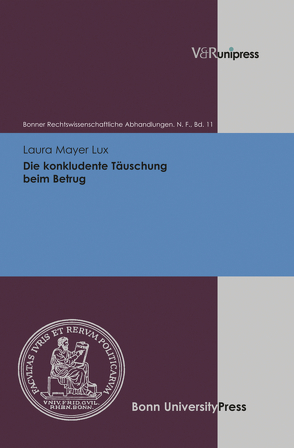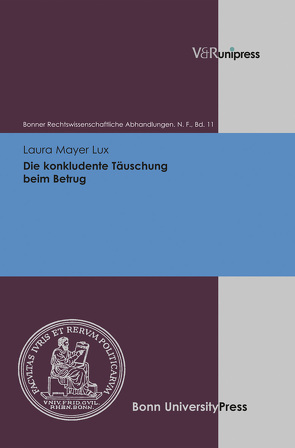
Die meisten Definitionsversuche von konkludenter Täuschung kommen über Leerformeln – etwa die »Verkehrsauffassung« – nicht hinaus. Im Gegensatz dazu kann Laura Mayer Lux aufzeigen, dass die schlüssige Täuschung eine aktive Täuschung ist, die einer unwahren Behauptung über betrugsrelevante Tatsachen entspricht. Mithilfe der analytischen Sprachphilosophie begründet die Autorin Betrug als »Kommunikationsdelikt« theoretisch und bestimmt Täuschung mit Bezug auf die kommunikative Interaktion zwischen Täter und Getäuschtem. Vor diesem Hintergrund wird deutlich, dass die konkludente Täuschung als »semantischer Schluss« bezeichnet werden kann, also als ein Schluss, der im Hinblick auf die Bedeutung des fraglichen kommunikativen Aktes konstruiert wird, und als »indirekte unwahre Informationsbehauptung« verstanden werden muss. This study seeks to contribute, through the analytical philosophy of language, to a theoretical framework of fraud as a “communication offense”. It also aims at determining the meaning of the deceit element – particularly, implied or tacit deceit – with reference to the communicative interaction between the offender and the victim of the deception. A thorough study of definitions of tacit deceit reveals that most researches come out with “empty formulas” – such as “prevailing public understanding” – which are unable to specify the deceit element. By contrast, this study argues that tacit deceit should be referred to as an active deceit. That is, an untrue statement about fraud-relevant facts, i.e., information which, depending on the economic relationship, may act as a determining factor for a rational disposition of property. Finally, this research clarifies tacit deceit as a “semantic deduction”, i.e., a deduction that is constructed in view of the meaning of the communicative act under analysis, and proposes that tacit deceit should be interpreted as an “indirect false assertion about information”
Aktualisiert: 2023-06-28
> findR *
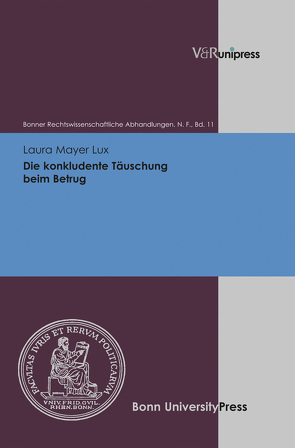
Die meisten Definitionsversuche von konkludenter Täuschung kommen über Leerformeln – etwa die »Verkehrsauffassung« – nicht hinaus. Im Gegensatz dazu kann Laura Mayer Lux aufzeigen, dass die schlüssige Täuschung eine aktive Täuschung ist, die einer unwahren Behauptung über betrugsrelevante Tatsachen entspricht. Mithilfe der analytischen Sprachphilosophie begründet die Autorin Betrug als »Kommunikationsdelikt« theoretisch und bestimmt Täuschung mit Bezug auf die kommunikative Interaktion zwischen Täter und Getäuschtem. Vor diesem Hintergrund wird deutlich, dass die konkludente Täuschung als »semantischer Schluss« bezeichnet werden kann, also als ein Schluss, der im Hinblick auf die Bedeutung des fraglichen kommunikativen Aktes konstruiert wird, und als »indirekte unwahre Informationsbehauptung« verstanden werden muss. This study seeks to contribute, through the analytical philosophy of language, to a theoretical framework of fraud as a “communication offense”. It also aims at determining the meaning of the deceit element – particularly, implied or tacit deceit – with reference to the communicative interaction between the offender and the victim of the deception. A thorough study of definitions of tacit deceit reveals that most researches come out with “empty formulas” – such as “prevailing public understanding” – which are unable to specify the deceit element. By contrast, this study argues that tacit deceit should be referred to as an active deceit. That is, an untrue statement about fraud-relevant facts, i.e., information which, depending on the economic relationship, may act as a determining factor for a rational disposition of property. Finally, this research clarifies tacit deceit as a “semantic deduction”, i.e., a deduction that is constructed in view of the meaning of the communicative act under analysis, and proposes that tacit deceit should be interpreted as an “indirect false assertion about information”
Aktualisiert: 2023-06-28
> findR *

Die meisten Definitionsversuche von konkludenter Täuschung kommen über Leerformeln – etwa die »Verkehrsauffassung« – nicht hinaus. Im Gegensatz dazu kann Laura Mayer Lux aufzeigen, dass die schlüssige Täuschung eine aktive Täuschung ist, die einer unwahren Behauptung über betrugsrelevante Tatsachen entspricht. Mithilfe der analytischen Sprachphilosophie begründet die Autorin Betrug als »Kommunikationsdelikt« theoretisch und bestimmt Täuschung mit Bezug auf die kommunikative Interaktion zwischen Täter und Getäuschtem. Vor diesem Hintergrund wird deutlich, dass die konkludente Täuschung als »semantischer Schluss« bezeichnet werden kann, also als ein Schluss, der im Hinblick auf die Bedeutung des fraglichen kommunikativen Aktes konstruiert wird, und als »indirekte unwahre Informationsbehauptung« verstanden werden muss. This study seeks to contribute, through the analytical philosophy of language, to a theoretical framework of fraud as a “communication offense”. It also aims at determining the meaning of the deceit element – particularly, implied or tacit deceit – with reference to the communicative interaction between the offender and the victim of the deception. A thorough study of definitions of tacit deceit reveals that most researches come out with “empty formulas” – such as “prevailing public understanding” – which are unable to specify the deceit element. By contrast, this study argues that tacit deceit should be referred to as an active deceit. That is, an untrue statement about fraud-relevant facts, i.e., information which, depending on the economic relationship, may act as a determining factor for a rational disposition of property. Finally, this research clarifies tacit deceit as a “semantic deduction”, i.e., a deduction that is constructed in view of the meaning of the communicative act under analysis, and proposes that tacit deceit should be interpreted as an “indirect false assertion about information”
Aktualisiert: 2023-06-28
> findR *
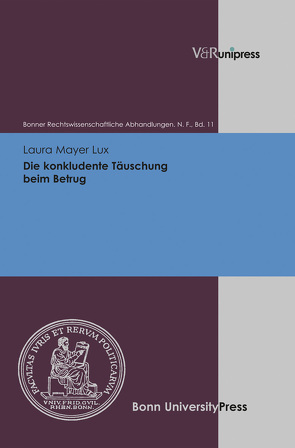
Die meisten Definitionsversuche von konkludenter Täuschung kommen über Leerformeln – etwa die »Verkehrsauffassung« – nicht hinaus. Im Gegensatz dazu kann Laura Mayer Lux aufzeigen, dass die schlüssige Täuschung eine aktive Täuschung ist, die einer unwahren Behauptung über betrugsrelevante Tatsachen entspricht. Mithilfe der analytischen Sprachphilosophie begründet die Autorin Betrug als »Kommunikationsdelikt« theoretisch und bestimmt Täuschung mit Bezug auf die kommunikative Interaktion zwischen Täter und Getäuschtem. Vor diesem Hintergrund wird deutlich, dass die konkludente Täuschung als »semantischer Schluss« bezeichnet werden kann, also als ein Schluss, der im Hinblick auf die Bedeutung des fraglichen kommunikativen Aktes konstruiert wird, und als »indirekte unwahre Informationsbehauptung« verstanden werden muss. This study seeks to contribute, through the analytical philosophy of language, to a theoretical framework of fraud as a “communication offense”. It also aims at determining the meaning of the deceit element – particularly, implied or tacit deceit – with reference to the communicative interaction between the offender and the victim of the deception. A thorough study of definitions of tacit deceit reveals that most researches come out with “empty formulas” – such as “prevailing public understanding” – which are unable to specify the deceit element. By contrast, this study argues that tacit deceit should be referred to as an active deceit. That is, an untrue statement about fraud-relevant facts, i.e., information which, depending on the economic relationship, may act as a determining factor for a rational disposition of property. Finally, this research clarifies tacit deceit as a “semantic deduction”, i.e., a deduction that is constructed in view of the meaning of the communicative act under analysis, and proposes that tacit deceit should be interpreted as an “indirect false assertion about information”
Aktualisiert: 2023-05-28
> findR *
Aktualisiert: 2019-04-23
> findR *
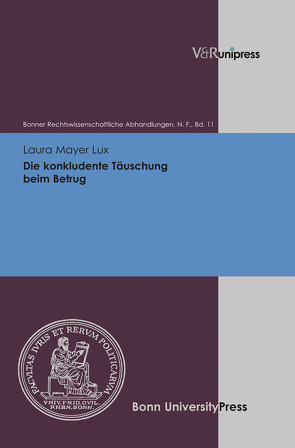
Die meisten Definitionsversuche von konkludenter Täuschung kommen über Leerformeln – etwa die »Verkehrsauffassung« – nicht hinaus. Im Gegensatz dazu kann Laura Mayer Lux aufzeigen, dass die schlüssige Täuschung eine aktive Täuschung ist, die einer unwahren Behauptung über betrugsrelevante Tatsachen entspricht. Mithilfe der analytischen Sprachphilosophie begründet die Autorin Betrug als »Kommunikationsdelikt« theoretisch und bestimmt Täuschung mit Bezug auf die kommunikative Interaktion zwischen Täter und Getäuschtem. Vor diesem Hintergrund wird deutlich, dass die konkludente Täuschung als »semantischer Schluss« bezeichnet werden kann, also als ein Schluss, der im Hinblick auf die Bedeutung des fraglichen kommunikativen Aktes konstruiert wird, und als »indirekte unwahre Informationsbehauptung« verstanden werden muss. This study seeks to contribute, through the analytical philosophy of language, to a theoretical framework of fraud as a “communication offense”. It also aims at determining the meaning of the deceit element – particularly, implied or tacit deceit – with reference to the communicative interaction between the offender and the victim of the deception. A thorough study of definitions of tacit deceit reveals that most researches come out with “empty formulas” – such as “prevailing public understanding” – which are unable to specify the deceit element. By contrast, this study argues that tacit deceit should be referred to as an active deceit. That is, an untrue statement about fraud-relevant facts, i.e., information which, depending on the economic relationship, may act as a determining factor for a rational disposition of property. Finally, this research clarifies tacit deceit as a “semantic deduction”, i.e., a deduction that is constructed in view of the meaning of the communicative act under analysis, and proposes that tacit deceit should be interpreted as an “indirect false assertion about information”
Aktualisiert: 2023-04-28
> findR *
MEHR ANZEIGEN
Bücher von Mayer Lux, Laura
Sie suchen ein Buch oder Publikation vonMayer Lux, Laura ? Bei Buch findr finden Sie alle Bücher Mayer Lux, Laura.
Entdecken Sie neue Bücher oder Klassiker für Sie selbst oder zum Verschenken. Buch findr hat zahlreiche Bücher
von Mayer Lux, Laura im Sortiment. Nehmen Sie sich Zeit zum Stöbern und finden Sie das passende Buch oder die
Publiketion für Ihr Lesevergnügen oder Ihr Interessensgebiet. Stöbern Sie durch unser Angebot und finden Sie aus
unserer großen Auswahl das Buch, das Ihnen zusagt. Bei Buch findr finden Sie Romane, Ratgeber, wissenschaftliche und
populärwissenschaftliche Bücher uvm. Bestellen Sie Ihr Buch zu Ihrem Thema einfach online und lassen Sie es sich
bequem nach Hause schicken. Wir wünschen Ihnen schöne und entspannte Lesemomente mit Ihrem Buch
von Mayer Lux, Laura .
Mayer Lux, Laura - Große Auswahl an Publikationen bei Buch findr
Bei uns finden Sie Bücher aller beliebter Autoren, Neuerscheinungen, Bestseller genauso wie alte Schätze. Bücher
von Mayer Lux, Laura die Ihre Fantasie anregen und Bücher, die Sie weiterbilden und Ihnen wissenschaftliche Fakten
vermitteln. Ganz nach Ihrem Geschmack ist das passende Buch für Sie dabei. Finden Sie eine große Auswahl Bücher
verschiedenster Genres, Verlage, Schlagworte Genre bei Buchfindr:
Unser Repertoire umfasst Bücher von
- Mayer M.A., Ute
- Mayer OSA, Cornelius Petrus
- Mayer Photography, Stephanie
- Mayer Scarnato, Wolfgang
- Mayer Tierfotografie, Andrea
- Mayer, A.
- Mayer, A.-K.
- Mayer, Abraham
- Mayer, Achim
- Mayer, Adalbert
Sie haben viele Möglichkeiten bei Buch findr die passenden Bücher für Ihr Lesevergnügen zu entdecken. Nutzen Sie
unsere Suchfunktionen, um zu stöbern und für Sie interessante Bücher in den unterschiedlichen Genres und Kategorien
zu finden. Neben Büchern von Mayer Lux, Laura und Büchern aus verschiedenen Kategorien finden Sie schnell und
einfach auch eine Auflistung thematisch passender Publikationen. Probieren Sie es aus, legen Sie jetzt los! Ihrem
Lesevergnügen steht nichts im Wege. Nutzen Sie die Vorteile Ihre Bücher online zu kaufen und bekommen Sie die
bestellten Bücher schnell und bequem zugestellt. Nehmen Sie sich die Zeit, online die Bücher Ihrer Wahl anzulesen,
Buchempfehlungen und Rezensionen zu studieren, Informationen zu Autoren zu lesen. Viel Spaß beim Lesen wünscht Ihnen
das Team von Buchfindr.




